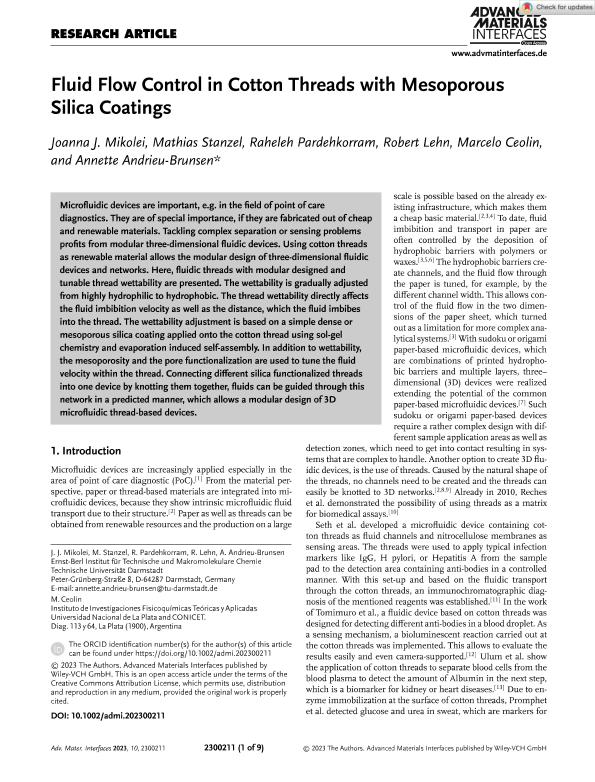Mostrar el registro sencillo del ítem
dc.contributor.author
Mikolei, Joanna J.
dc.contributor.author
Stanzel, Mathias
dc.contributor.author
Pardehkorram, Raheleh
dc.contributor.author
Lehn, Robert
dc.contributor.author
Ceolin, Marcelo Raul

dc.contributor.author
Andrieu Brunsen, Annette
dc.date.available
2024-02-15T15:10:22Z
dc.date.issued
2023-07
dc.identifier.citation
Mikolei, Joanna J.; Stanzel, Mathias; Pardehkorram, Raheleh; Lehn, Robert; Ceolin, Marcelo Raul; et al.; Fluid Flow Control in Cotton Threads with Mesoporous Silica Coatings; John Wiley & Sons; Advanced Materials Interfaces; 10; 21; 7-2023; 1-9
dc.identifier.uri
http://hdl.handle.net/11336/227089
dc.description.abstract
Microfluidic devices are important, e.g. in the field of point of care diagnostics. They are of special importance, if they are fabricated out of cheap and renewable materials. Tackling complex separation or sensing problems profits from modular three-dimensional fluidic devices. Using cotton threads as renewable material allows the modular design of three-dimensional fluidic devices and networks. Here, fluidic threads with modular designed and tunable thread wettability are presented. The wettability is gradually adjusted from highly hydrophilic to hydrophobic. The thread wettability directly affects the fluid imbibition velocity as well as the distance, which the fluid imbibes into the thread. The wettability adjustment is based on a simple dense or mesoporous silica coating applied onto the cotton thread using sol-gel chemistry and evaporation induced self-assembly. In addition to wettability, the mesoporosity and the pore functionalization are used to tune the fluid velocity within the thread. Connecting different silica functionalized threads into one device by knotting them together, fluids can be guided through this network in a predicted manner, which allows a modular design of 3D microfluidic thread-based devices.
dc.format
application/pdf
dc.language.iso
eng
dc.publisher
John Wiley & Sons

dc.rights
info:eu-repo/semantics/openAccess
dc.rights.uri
https://creativecommons.org/licenses/by/2.5/ar/
dc.subject
MICROFLUIDIC IN THREADS
dc.subject
NANOPORE FUNCTIONALIZATION
dc.subject
NANOPORES
dc.subject
SILICA COATINGS
dc.subject
SOL-GEL-CHEMISTRY
dc.subject
SURFACE MODIFICATION
dc.subject.classification
Físico-Química, Ciencia de los Polímeros, Electroquímica

dc.subject.classification
Ciencias Químicas

dc.subject.classification
CIENCIAS NATURALES Y EXACTAS

dc.title
Fluid Flow Control in Cotton Threads with Mesoporous Silica Coatings
dc.type
info:eu-repo/semantics/article
dc.type
info:ar-repo/semantics/artículo
dc.type
info:eu-repo/semantics/publishedVersion
dc.date.updated
2024-02-14T12:42:12Z
dc.identifier.eissn
2196-7350
dc.journal.volume
10
dc.journal.number
21
dc.journal.pagination
1-9
dc.journal.pais
Estados Unidos

dc.journal.ciudad
Nueva Jersey
dc.description.fil
Fil: Mikolei, Joanna J.. Universitat Technische Darmstadt; Alemania
dc.description.fil
Fil: Stanzel, Mathias. Universitat Technische Darmstadt; Alemania
dc.description.fil
Fil: Pardehkorram, Raheleh. Universitat Technische Darmstadt; Alemania
dc.description.fil
Fil: Lehn, Robert. Universitat Technische Darmstadt; Alemania
dc.description.fil
Fil: Ceolin, Marcelo Raul. Consejo Nacional de Investigaciones Científicas y Técnicas. Centro Científico Tecnológico Conicet - La Plata. Instituto de Investigaciones Fisicoquímicas Teóricas y Aplicadas. Universidad Nacional de La Plata. Facultad de Ciencias Exactas. Instituto de Investigaciones Fisicoquímicas Teóricas y Aplicadas; Argentina
dc.description.fil
Fil: Andrieu Brunsen, Annette. Universitat Technische Darmstadt; Alemania
dc.journal.title
Advanced Materials Interfaces
dc.relation.alternativeid
info:eu-repo/semantics/altIdentifier/url/https://onlinelibrary.wiley.com/doi/10.1002/admi.202300211
dc.relation.alternativeid
info:eu-repo/semantics/altIdentifier/doi/http://dx.doi.org/10.1002/admi.202300211
Archivos asociados
